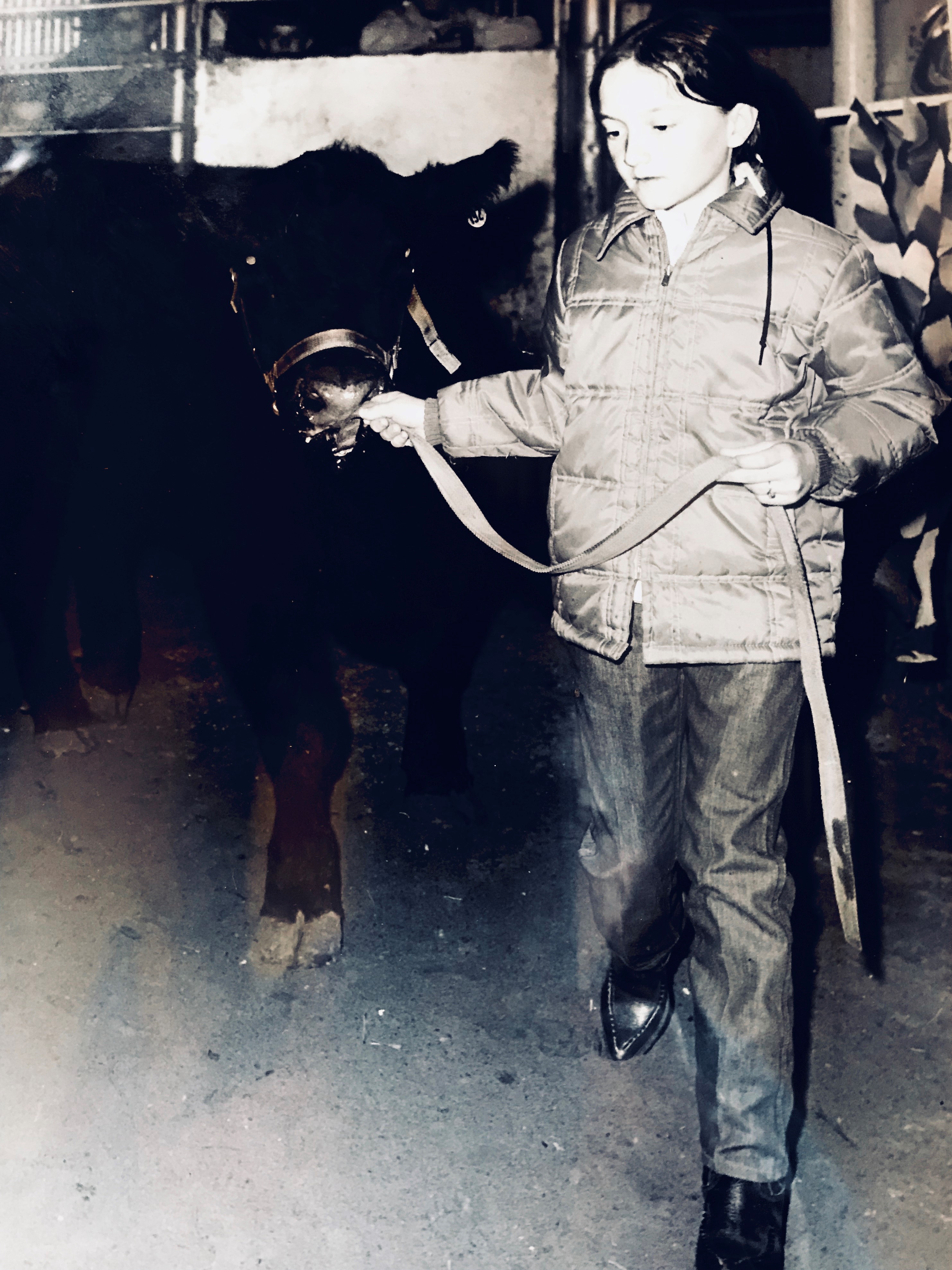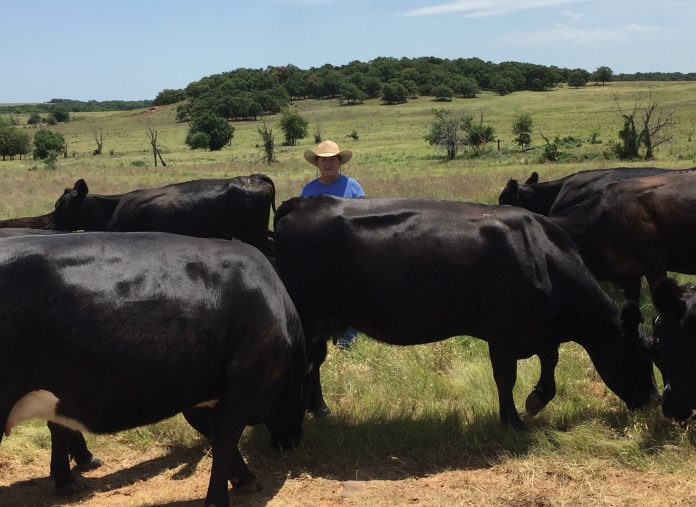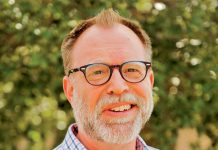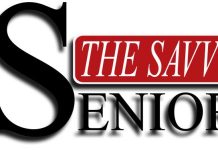by Bryan Painter

LOCO – Cattle and horses over people.
Jerri Wilson, raised near Duncan in southern Oklahoma, made that choice about the time she was still shedding baby teeth.
Horseback at every opportunity, Wilson would carry her lunch around in her saddle bags. Why?
“If it was even mentioned about going to town,” she said, “I became scarce out in the pastures.”
She was born to Billie and (Ed) John E Jackson, Jr. and grew up on the commercial Angus cow-calf ranch in southern Stephens and northern Jefferson counties. Ed Jackson purchased the ranch the year Wilson was born, 1959, and expanded it to 23,000 acres.
Billie and Ed had four daughters. Their names started with J so it was called the 4J ranch.
Wilson was the youngest and grew up following her father around taking care of the cattle.
“The others did not take up much to cattle and the country life,” she said. “I was quite the tomboy, staying out with the cattle all day.”
Wilson’s love for taking care of cattle and the land was not a secret. Everyone could see it.
“Our ranch was far from school,” she said. “I was the first one on and the last one off the school bus for two hours each way and spent many hours looking at cattle and pastures along the way.”
Add those round-trips up from grade school through high school and that’s a lot of miles.
Not long after the bus came to a stop near their house, Wilson was out on her paint pony riding through the cattle and across pastures.
“At branding and shipping time,” she said, “myself, and the other kids on the ranch were in the mix of helping. I thank all of the adults from back then for allowing us to be there because it was what shaped my future.”
More responsibility
As she got older, Wilson’s responsibilities grew. She worked cattle, took care of the cattle and horses, and doctored the sick ones.
Wilson also began showing cattle at the county and state level.
“I really think that was the point that I knew I would always have cattle in my blood,” she said. “At that time, everyone would show home-raised steers. I remember running down to the barn and feeding in the dark before getting on the bus.”
At 13, she showed heifers, but they had to be registered.
“I was fortunate that our neighbor, Mr. Phil Lowery, raised registered Herefords for years,” she said. “I had been riding my pony up the road to help him gather his cattle and I told him I needed to buy one of his heifers to show. He said, ‘Pick one out.’”
Lowery gave her a heifer every year through high school as payment for helping him with his cattle.
“His operation was much different than our commercial herd,’’ Wilson said. “I would ride around in his pickup with him and listen to all the pedigrees.”
Lowery kept little breeding books, with a rubber band around them, on his dusty dash. Wilson studied those little books.
“I built my first herd with those registered Herefords and still have a little Hereford patch for sentimental reasons,” Wilson said.
One of her other passions was livestock judging and grass identification. She went to numerous contests and loved all the aspects of learning.
4-H was a big part of her life, and the horses she took to 4-H and Quarter Horse events were not only for showing.
“They were also my cow horses back on the ranch,” Wilson said.
In high school, she started going to the state high school rodeos. That’s where she met her future husband Bob Wilson. The two married after high school, in June, 1977.
“For a couple of years we lived in Elk City,” she said. “Bob worked there during the oil and gas boom and of course I dragged a few cows along with us.”
As her Dad was getting older, he had heart problems, so Bob and Jerri returned to Ed’s ranch where they lived and worked.
The Wilsons had three daughters, Kristy, Kerri and Kayla.
When Jerri Wilson’s father passed away, the family dispersed the ranch and cattle.
Wilson, 30 years old at the time, and Bob, began their own ranching operation near Loco. They put together enough acreage to get a start, so they bought four loads of commercial Angus bred heifers.
“The timing was not great,” Wilson said. “The cattle market was on a low, so Bob began driving a Peterbilt with a flatbed.”
Bob hauled nationwide for a local wire plant which allowed “us to let the cows pay for themselves.”
“As soon as that was done, he stopped,” she said.
While he was gone, Wilson was feeding cattle and taking care of their first grandson.
“By now our two youngest daughters were beginning to show cattle and loved it,” Wilson said. “It had changed dramatically from my days. Hair products and clipping were much different. There was a lot of learning to do.
“Along the way I bought a couple of Simmental heifers for them to show and liked the way they performed and their temperaments.”
So, from artificial breeding the heifers, and purchasing some purebred and percentage bulls, they started breeding Simmental into their cow herd.
“Now we have a SimAngus cow base and have been breeding them to registered Angus bulls,” she said.
A dusty memory
During the fall of 2010, it seemed the Oklahoma skies had started to dry up.
Rains became a dusty memory.
“We had some really tough years during the drought,” she said. “From 2010 to 2013 we culled our cow herd by a third because there was no pond water. We had some wells dug for them but it is very hard to get water in this area.”
Plus, in February 2011, Bob broke his wrist in a shop accident.
“Then in August, him and his horse parted ways on a large crack in the ground from the drought and he broke his hip,” Wilson said. “It was a very tough year for him.”
A hired hand helped for about three years before moving back to Nebraska. Challenging decisions had to be made.
“At the time, there was not enough water so the calves were taken off at 400 pounds and we sent them to a feedlot which is not what we normally do,” she said. “Normally our calves are left on the cows till they are 500 to 600 pounds.
“In the end it improved our cowherd into productive beautiful cows that I am very proud of. We have been selling a lot of our heifers for breeding or as bred heifers. Steers and heifers not for breeding are sold through National Livestock at the Oklahoma City stockyards or sold at home.”
Over the years, Jerri and Bob have purchased more land and have doubled their size from what they started with, “which has been gratifying to improve those areas.” They have done a lot of clearing brush, sprigging Bermuda and weed spraying to improve the grass for cattle, while yet always being mindful of the wildlife.
They are also mindful of the future. In addition to three children, they have six grandchildren.
“So who knows, maybe some of them will continue in a ranching lifestyle,” Wilson said. “In the cattle business it’s a lot of long days and hard work but it is a lifestyle that I love and have a passion for.”














